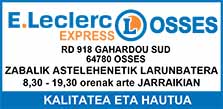Ben Groundwater. They don't stare for long, it's more a long glance, but the message is the same: there's a stranger in town.
Not many tourists darken the normal-sized doors at Bar Ricardo, a classic, no-frills boozer in the San Sebastian neighbourhood of Gros. This is where locals come to drink beer and smoke cigars, to chat in their native Basque and to watch as their beloved football team, Real Sociedad, takes the field for another match.
There's sawdust on the floor here; precious few snacks on display in the cabinets. The barman smiles a gap-toothed smile as he greets new customers with a simple ''dime'' - pronounced ''dee-may'', which essentially just means ''tell me''. As in, what do you want? Tell me. No pretences. No graces.
You have to love Bar Ricardo. It's a throwback, a defiantly shabby old joint in a city where shabby just doesn't cut in anymore. In the rest of San Sebastian, particularly just across the river in the Parte Vieja, or Old Town, everyone is going upmarket, catering to the tourist crowd, trying to impress with designer furnishings and bars groaning under the weight of Michelin-star-worthy cuisine.
But not Ricardo. It's a mark of the way San Sebastian once was, and the way the Gros neighbourhood, in some ways, still is.
This is a suburb in flux, says Bella Bowring, the co-owner of Gros restaurant Gerald's who has called this suburb home for four years. ''Traditionally, Gros was a place with lots of mechanics and garages,'' she says, ''with people who did printing - it was very commercial. There were local bars, but there's been a movement since San Sebastian became a popular tourist destination, the locals have moved out of the Old Town and there's been quite a scene created in Gros.''
Ricardo is a great starting point for any experience of Gros, despite that fact it's not part of that scene. It's Gros the way Gros used to be; Gros the way it probably never will be again. This area always had far too much going for it to remain a commercial hub for long.
Gros lies on the shores of Playa Zurriola, one of San Sebastian's two beaches, a major attraction for surfers and sun-lovers. It's stumbling distance from the Parte Vieja, ground zero for the Basque Country's gastronomic scene. It's a short wander, too, from Playa de la Concha, San Sebastian's famous crescent-shaped patch of sand.
If you want to see where locals live, and how locals live in this part of northern Spain, you have to come to Gros. The streets here are lined with the shops that make Basque Country tick: fishmongers doling out fresh seafood to the masses, bakeries churning out warm bread, supermarkets, kitchen supply stores, restaurants, and most important of all, pintxos bars.
While the Parte Vieja is the most popular spot for visitors to enjoy the Basque version of tapas, for locals it's all about Gros. ''The feeling I get in the Old Town these days is that there's a lot of new bars that are catering to the tourist crowd,'' says Bella from Gerald's. ''It's also packed there; in the summer months, it's impossible. Gros is a bit more relaxed. There's more space, so there are more options for opening up new places. I guess it's more of a local vibe here.''
If you want to see where locals live, and how locals live in this part of northern Spain, you have to come to Gros.
That extra space has allowed for a spate of more experimental, international-influenced establishments to flourish in Gros. Gerald's is one of them, sister restaurant to the Melbourne eatery of the same name, serving up produce-driven, pan-European cuisine. There's Sakona, too, a coffee roaster and cafe that does the closest thing to a perfect flat white that desperate Australian visitors are likely to find.
There are Peruvian fusion restaurants in Gros, Italian restaurants, Japanese restaurants, and even a Pakistani joint at the far eastern end - new and unusual eateries that nestle in next to traditional old Basque bars like Ricardo, and new-school pintxos joints such as Eguzki. You'll find craft beer shops and organic groceries and juice bars standing next to gourmet delis and pop-up weekend farmers' markets.
Gros has a flourishing fashion scene too, with local designers making use of all that space. ''There's so many boutique stores and independent businesses, rather than massive chains,'' says Bella. ''It's a lovely mix, because there are a lot of new places, but also clothing shops that have been around for years. A lot of the old workshop spaces have been revitalised, too.''
With such an eclectic mix of ages and influences, it can be hard to pin Gros down sometimes, to declare it traditional or innovative, old-fashioned or edgy. In truth, it's all of those things and probably more, depending on where on its narrowed, criss-crossed streets you happen to be.
The loose thread that ties the neighbourhood together is the feeling that the people who work here and eat here and drink here and shop here are the same people who live in the apartment blocks that line the streets. ''The community here is something that's really important,'' says Bella. ''I try to buy from local shops, and use local hardware stores ... we have a strong local following, and it's nice to feel that.''
To become part of this community, simply walk through the doors.
Ben Groundwater travelled at his own expense



 Send to a friend
Send to a friend Add comment
Add comment








